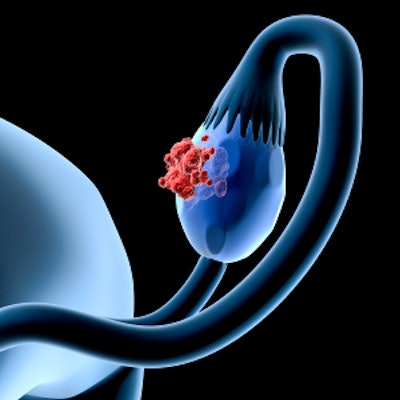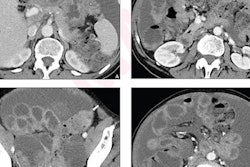
The Ovarian-Adnexal Reporting and Data System (O-RADS) ultrasound risk stratification system performed within the expected range specified by the American College of Radiology (ACR) in a study published June 9 in JAMA Network Open.
Researchers led by Dr. Priyanka Jha from the University of California, San Francisco found that an O-RADS ultrasound score of four was the optimum cutoff for diagnosing ovarian cancer, as well as a low frequency of malignant neoplasm.
"These findings validated O-RADS utilization in a general, everyday practice and will promote confident utilization of uniform lexicon, malignancy risk estimation based on morphological evaluation and management strategies," Jha told AuntMinnie.com. "Eventually, this will prevent surgery for benign lesions and expedite gynecology oncology referral for malignant lesions."
When an adnexal lesion is discovered on pelvic ultrasound, it's important to classify it as benign or potentially malignant. This in turn helps with recommending appropriate follow up, including potential referral to gynecology oncology.
The study authors wrote that "most" adnexal lesions found on ultrasound are benign and can be classified as simple cysts, hemorrhagic cysts, endometriomas, and dermoids. These carry low risk of developing into cancer, but lesions not meeting the criteria for these four classifications carry increased risk.
The ACR in 2018 developed the O-RADS system via a committee of clinicians and researchers from the fields of radiology, gynecology, pathology, and gynecologic oncology.
The system is based on published terminology and prospective studies. This includes data from the International Ovarian Tumour Analysis (IOTA) study, which was collected between 1999 to 2012 in women referred for surgery of known adnexal lesions. The estimates for malignant neoplasm in risk scoring with this system are based on the calculated frequency from women undergoing surgery for known adnexal lesions.
Recent studies on the risk score's diagnostic performance were performed in Europe, Asia, and the Middle East. The researchers wrote that the frequency of malignant neoplasm in these cohorts is nearly 30% but the population demographics and the ultrasonography performance don't reflect clinical practice patterns of U.S. radiology departments.
Jha and colleagues wanted to study the O-RADS ultrasound risk stratification system in a nonselected population of U.S. women who presented to radiology departments. They focused on centers where technologists scan patients, writing that in the U.S., "many" of the ultrasound exams are performed by sonographers.
The researchers looked at data from 913 women with 1,014 adnexal lesions. The women had an average age of 42.4 years, and 674 were premenopausal. The study population included women undergoing surgery as well as clinical and imaging follow-up. The authors wrote that this was done to eliminate verification bias of studies with a high percentage of surgically resected lesions.
The team found that the overall frequency of malignant neoplasm was 8.4% (85 adnexal lesions) and fell below expected projections with each score.
| Calculated frequency of malignant neoplasm for O-RADS ultrasound risk scoring system vs. expected projections for stratifying adnexal lesions | ||
| Score | Projected estimate | Calculated estimate |
| O-RADS 2 | < 1% | 0.5% |
| O-RADS 3 | < 10% | 4.5% |
| O-RADS 4 | 10% to 50% | 11.6% |
| O-RADS 5 | > 50% | 65.6% |
Jha et al also found that O-RADS US 4 was the best cutoff for diagnosing cancer with sensitivity of 90.6%, specificity of 81.9%, positive predictive value of 31.4%, and negative predictive value of 99%.
They added that adnexal lesions that were scored as O-RADS 2 or 3 had a "very low chance" of cancer, supporting conservative management for these lesions.
The authors concluded that their results support using O-RADS ultrasound risk stratification system in a no-selected population of U.S. women.
"When applied to women in the U.S. presenting to radiology departments for pelvic ultrasonography, the calculated frequency of malignant neoplasm for each of the O-RADS ultrasound score fell within the lower end of the expected range of the published O-RADS risk stratification algorithm," they wrote.
Jha told AuntMinnie.com that future plans include studying imaging features that are most strongly predictive of malignancy, as well as that help identify features that will increase the specificity of the system.




















